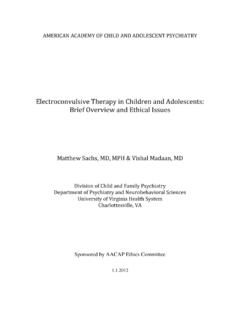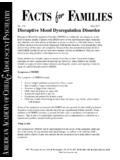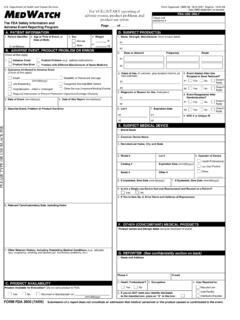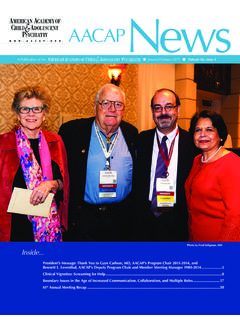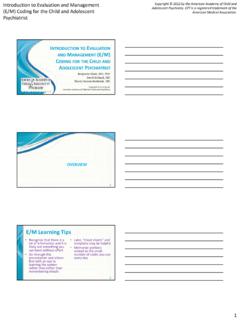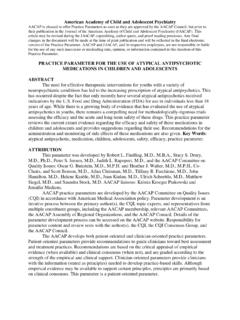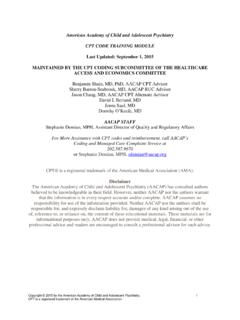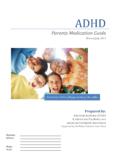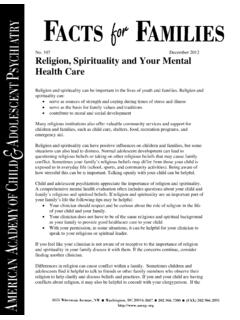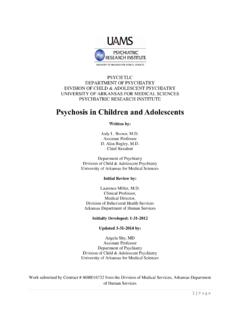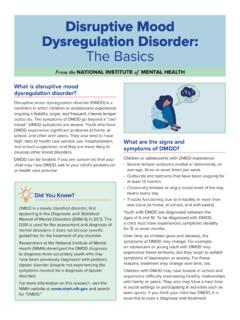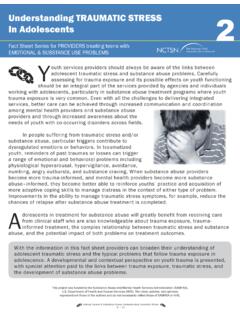Transcription of Practice Parameter for the Assessment and Treatment of ...
1 Copyright @ 2007 American Academy of Child and Adolescent Psychiatry. Unauthorized reproduction of this article is Parameter for the Assessment and Treatmentof children and Adolescents With Attention-Deficit/Hyperactivity DisorderABSTRACTThis Practice Parameter describes the Assessment and Treatment of children and adolescents with attention-deficit/hyperactivity disorder (ADHD) based on the current scientific evidence and clinical consensus of experts in the field. Thisparameter discusses the clinical evaluation for ADHD, comorbid conditions associated with ADHD, research on theetiology of the disorder, and psychopharmacological and psychosocial interventions for Am. Acad. ChildAdolesc. Psychiatry, 2007;46(7) Words:attention-deficit/hyperactivity disorder, evaluation, Treatment , Practice disorder (ADHD;American Psychiatric Association, 2000) is one of themost common childhood psychiatric conditions.
2 It hasbeen the focus of a great deal of scientific and clinicalstudy during the past century. Upon reviewing thevoluminous literature on ADHD, the AmericanMedical Association s Council on Scientific Affairs(Goldman et al., 1998) commented,BOverall, ADHDis one of the best-researched disorders in medicine, andthe overall data on its validity are far more compellingthan for many medical conditions.^Although scientistsand clinicians debate the best way to diagnose and treatADHD, there is no debate among competent and well-informed health care professionals that ADHD is avalid neurobiological condition that causes significantimpairment in those whom it afflicts. These guidelinesseek to lay out evidence-based guidelines for theeffective diagnosis and Treatment of this Parameter , the termpreschoolersrefers tochildren ages 3 through 5 years, the termchildrenrefersto children ages 6 through 12 years, and the termadolescentsrefers to minors ages 13 through 17 to parent or legal any minor with ADHD.
3 The terminology in thispractice Parameter is consistent with that ofDSM-IV-TR(American Psychiatric Association, 2000).METHODOLOGYThe list of references for this Parameter wasdeveloped by searchingPsycINFO,Medline,andPsychologic al Abstracts; by reviewing the bibliographiesAccepted February 18, Parameter was developed by Steven Pliszka, , principal author, andthe AACAP Work Group on Quality Issues: William Bernet, , OscarBukstein, , and Heather J. Walter, , Co-Chairs; Valerie Arnold, ,Joseph Beitchman, , R. Scott Benson, , Allan Chrisman, , TiffanyFarchione, , John Hamilton, , Helene Keable, , Joan Kinlan, , Jon McClellan, , David Rue, , Ulrich Schoettle, , Jon , , and Saundra Stock, AACAP Staff: Kristin Kroeger Ptakowskiand Jennifer authors acknowledge the following experts for their contributions to thisparameter.
4 Larry Greenhill, , Timothy Wilens, , Thomas Spencer, ,Joe Biederman, , Mina Dulcan, , Lily Hechtman, , PaulHammerness, , John Hamilton, , Caryn Carlson, , GregoryFabiano, , William Pelham, , James Swanson, , and DanielWaschbusch, Parameter was reviewed at the Member Forum at the Annual Meeting ofthe AACAP in October July 2006 to September 2006, this Parameter was reviewed by aConsensus Group convened by the Work Group on Quality Issues. ConsensusGroup members and their constituent groups were as follows: Work Group onQuality Issues (Oscar Bukstein, , Allan Chrisman, , R. Scott Benson, , and John Hamilton, ), Topic Experts (Larry Greenhill, ,and Russell Barkley, ), AACAP Work Group on Research (Larry Greenhill, ), AACAP Assembly of Regional Organizations (Joan Gerring, , andGuy Palmes, ), and AACAP Council (Cynthia W.)
5 Santos, , andCatherine Jaselskis, ).Disclosures of potential conflicts of interest for authors and Work Group chairsare provided at the end of the Parameter . Disclosures of potential conflicts ofinterest for all other individuals named above are provided on the AACAP Website on the Practice Information Practice Parameter was approved by the AACAP Council on October 18, Practice Parameter is available on the Internet ( ).Reprint requests to the AACAP Communications Department, 3615 WisconsinAvenue NW, Washington, DC 2007 by the American Academy of Child andAdolescent : OFFICIAL ACTION894J. AM. ACAD. CHILD ADOLESC. PSYCHIATRY, 46:7, JULY 2007 Copyright @ 2007 American Academy of Child and Adolescent Psychiatry. Unauthorized reproduction of this article is book chapters and review articles; by asking col-leagues for suggested source materials; and from theprevious version of this Parameter .
6 The searches wereconducted from September 2004 through April 2006for articles in English using the key wordBattention-deficit/hyperactivity disorder.^The search covered theperiod 1996 to 2006 and yielded approximately 5,000references. Recent authoritative reviews of literature, aswell as recent Treatment studies that were in press orpresented at scientific meetings in the past 2 to 3 years,were given priority for inclusion. The titles and abstractsof the remaining references were reviewed for particularrelevance and selected for inclusion when the referenceappeared to inform the field on the diagnosis and/ortreatment of AND CLINICAL COURSER ecently, epidemiological studies have more pre-cisely defined the prevalence of ADHD and the extentof its Treatment with medication.
7 Rowland et al. (2002)surveyed more than 6,000 parents of elementary schoolchildren in a North Carolina county. Ten percent of thechildren had been given a diagnosis of ADHD and 7%were taking medication for ADHD. Parents of 2,800third through fifth graders were surveyed in RhodeIsland; 12% of parents reported that their child hadbeen referred for evaluation and 6% were receivingmedication (Harel and Brown, 2003). An epidemiolo-gical study of nearly 6,000 children in Rochester, MN,found a cumulative incidence of ADHD in theelementary and secondary school population of (95% confidence interval ; Barbaresi et al.,2002), which was similar to a prevalence ofADHD found by the National Health InterviewSurvey for the period 1997Y2000 (Woodruff et al.)
8 ,2004). The Centers for Disease Control and Prevention(2005) conducted the National Survey of children sHealth during January 2003Y2004, asking parents ofmore than 100,000 children ages 4 to 17 years whethertheir child had ever been diagnosed with ADHD orreceived medication Treatment (as opposed to currentlybeing treated). The rate of lifetime childhood diagnosisof ADHD was , whereas (or only 55% ofthosewithADHD)hadeverbeentreatedwithme dication for the studies have begun to delineate the lifecourse of ADHD. A majority (60%Y85%) of childrenwith ADHD will continue to meet criteria for thedisorder during their teenage years (Barkley et al.,1990; Biederman et al., 1996; Claude and Firestone,1995), clearly establishing that ADHD does not remitwith the onset of puberty alone.
9 Defining the numberof children with ADHD who continue to haveproblems as adults is more difficult because ofmethodological issues reviewed by Barkley (2002).These include changes in informant (parent versuschild), use of different instruments to diagnoseADHD in adults, comorbidity of the other psychia-tric disorders in the childhood sample (less comorbidsamples have better outcome), and issues with theDSM-IVdiagnostic criteria themselves. The criteriaare designed for school-age children with regard tothe number of symptoms required to meet thediagnostic threshold ( , six of the nine symptomsfor inattention and/or hyperactivity/impulsivity),which may be developmentally inappropriate foradults.
10 That is, an adult may suffer significantimpairment even though he or she suffers fromfewer than six of nine symptoms in these areas. Thepersistence of the full syndrome of ADHD in youngadulthood has been found to range from 2% to 8%when self-report is used (Barkley et al., 2002;Mannuzza et al., 1993). In contrast, when parentreport is used, the prevalence increases to 46% andwhen a developmental definition of disorder is used(98th percentile), it increases further to 67% (Barkleyet al., 2002). Biederman et al. (2000) found thatthe rates of ADHD in adults varied according tonumber of symptoms and level of impairmentrequired for the diagnostic threshold. Although only40% of 18- to 20-year-oldBgrown up^ADHD patients met the full criteria for ADHD, 90% hadat least five symptoms of ADHD and a GlobalAssessment of Functioning score below 60.
